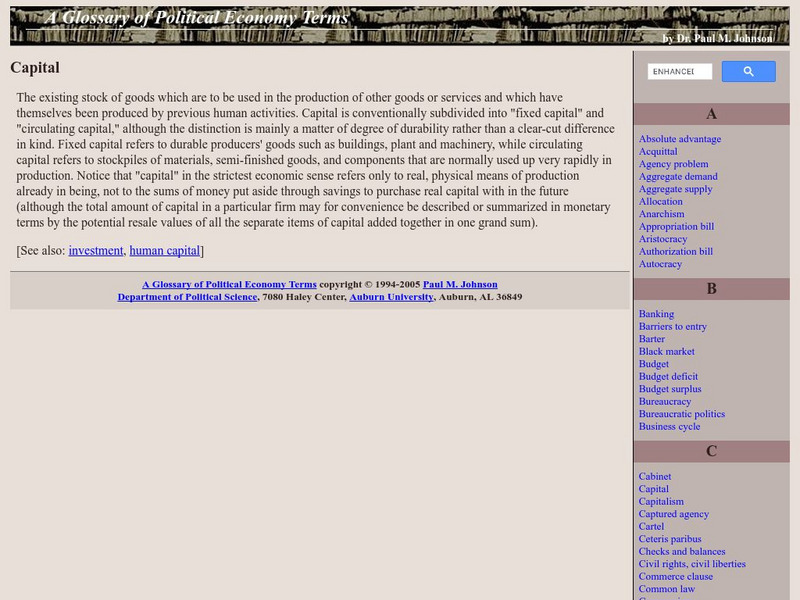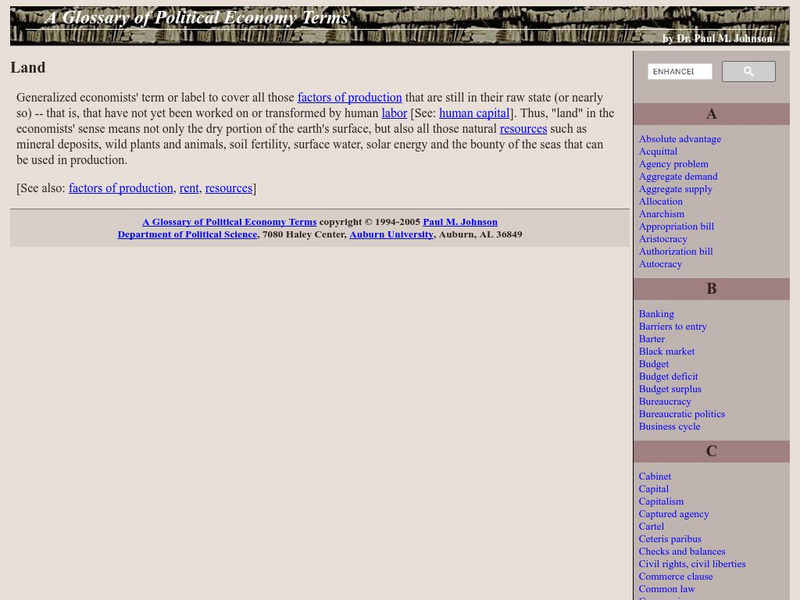Curated OER
Factors of Production
This site offers a good description and examples of the factors of production.
Council for Economic Education
Econ Ed Link: Baseball Economics 201
Some believe our national pastime may be threatened by the big market, high revenue teams like the Yankees (or the New York Mets, Chicago Cubs, Boston Red Sox, etc.) and that smaller market teams (e.g., the Florida Marlins, San Diego...
Council for Economic Education
Econ Ed Link: The Economics of the Family Farm
Learn about the status of farming as a career, investigate the management of a family farm, and examine one recent farm crisis in this lesson.
Khan Academy
Khan Academy: Lesson Overview: Consumer and Producer Surplus
This lesson introduced the basics of a branch of economics known as welfare economics, which is interested in how the allocation of resources affects well-being. The most important concepts used in welfare analysis are total surplus and...
Council for Economic Education
Econ Ed Link: Those Golden Jeans
Check out this informative economics lesson plan designed to review the three productive resources--natural resources, human resources, and capital resources--needed to produce goods and services.
Council for Economic Education
Econ Ed Link: Clipping Coupons
Explore this website to find out how and why consumers make choices on what products to buy. Learn how producers entice consumers into buying their products. This is a very informative lesson plan.
Council for Economic Education
Econ Ed Link: The Price of Gasoline: What's Behind It?
In this lesson plan, students investigate the variables that contribute to the cost of gasoline. They learn that while OPEC nations do influence the price of oil and thus the price of gasoline, other factors also influence the price.
Federal Reserve Bank
Federal Reserve Bank of Atlanta: Circular Flow
Explains how resources, goods and services, and payments flow through the economy using the economic model of circular flow.
Auburn University
Auburn University: Glossary of Political Economy Terms: Capital
This Auburn University site has a definition for capital as an economist would use the term.
Auburn University
Auburn University: A Glossary of Political Economy Terms: Land
Provides a definition for land as seen by an economist.
Curated OER
Biz/ed: Sources of Growth Where Does It Come From? [Virtual Economy]
Describes four essential sources of economic growth.
Tutor2u
Tutor2 U: Economies of Scope
This site is an explanation of several factors that impact mass production. Primarily, the concept of economies of scope is explored.
Robert Schenk, PhD
Cybereconomics: Circular Flow Diagram
This site gives a description and has a picture of a circular flow diagram. Description is well-written and easy to understand. A good overview of the flow of goods and services.
Council for Economic Education
Econ Ed Link: Incentives Influence Us
Find out more about the concept of incentives in our economy through this lesson plan. "You will identify incentives used at home and school."
Council for Economic Education
Econ Ed Link: Business Ownership: The Franchise Option
Students explore an alternative to starting a business from scratch- investing in a franchise. They begin by considering the pros and cons of a franchise and whether this form of business is an option that would fit their personality and...
Council for Economic Education
Econ Ed Link: Clipping Coupons
In this lesson, students will calculate savings for different products when using coupons. They will also decide what factors will influence the choices they make when choosing products.
Federal Reserve Bank
Federal Reserve Bank of Minneapolis: Real Business Cycles: A Legacy of Countercyclical Policies
This article explores the relationship of a real business cycle theory to existing and prospective countercyclical policies. (Published March 1, 1999)
Other
Branksome Hall Asia: Design and Inquiry: Sustainable Design
Sustainable design is a philosophy of developing products in line with social, economic, and ecological sustainability principles. In design, it is important to understand the distinction between Green Design and Sustainable Design....
US Energy Information Administration
U.s. Eia Energy Kids: Renewable Energy: Wind
Mankind has used the wind as an energy source for thousands of years. Discover other ways the wind is used to make energy.







![Biz/ed: Sources of Growth Where Does It Come From? [Virtual Economy] Activity Biz/ed: Sources of Growth Where Does It Come From? [Virtual Economy] Activity](https://content.lessonplanet.com/knovation/original/114981-943d0d0702e767059b8d1620d114047e.jpg?1661446511)



